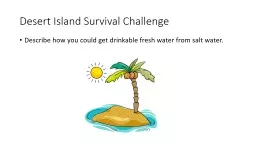

Describe how you could get drinkable fresh water from salt water Lesson 7 Separating Mixtures Learning Objectives Describe that a mixture consists of two or more elements or compounds not chemically combined ID: 643295
Download Presentation The PPT/PDF document "Desert Island Survival Challenge" is the property of its rightful owner. Permission is granted to download and print the materials on this web site for personal, non-commercial use only, and to display it on your personal computer provided you do not modify the materials and that you retain all copyright notices contained in the materials. By downloading content from our website, you accept the terms of this agreement.
Slide1
Desert Island Survival Challenge
Describe how you could get drinkable fresh water from salt water.Slide2
Lesson 7 – Separating Mixtures
Learning Objectives:
Describe that a
mixture consists of two or more elements or compounds not chemically combined
together and where the
chemical properties of each substance in the mixture are unchanged
.
Explain the following method of separating mixtures; a) filtration, b) crystallisation, c) simple distillation, d) fractional distillation, and e) chromatography.
Suggest
suitable separation and purification techniques for mixtures when given appropriate
information.Slide3
Mixtures
A mixture consists of two or more elements or compounds
not
chemically combined together.
The
chemical properties
of each substance in the mixture are unchanged.Mixtures can be separated by physical processes (NO chemical reactions involved).Slide4
What do you know about…
Separation Techniques?Write down explanations for the following separation techniques. How does it work? What types of mixtures does it separate? Include ideas about particles in your explanations if you can.
Filtration
Crystallisation
Distillation
Fractional Distillation
ChromatographySlide5
Filtration
Separates
: insoluble solids from a liquid
Physical Property
: solubility
How does it work
: Filter paper contains small holes that allow water molecules and soluble particles to pass through (filtrate).Insoluble solids have atoms which are still bonded together in a large molecule that cannot pass through the holes and is trapped by the filter paper (
residue
).
Filtrate
=
Filtered liquid
Residue
=
Insoluble solidSlide6
Crystallisation
Separates
: soluble solids from a solution
Physical Property
: solubility
How does it work
: Evaporating a liquid from a solution will produce a supersaturated solution (there is more solute in the solution than the solubility limit).Once the solution cools, the solid cannot stay in solution past it’s solubility limit and crystallises
.Slide7
Distillation
Separates
: liquid from a solution or mixture of two liquids
Physical Property
: boiling point
How does it work
: Mixtures is heated to the boiling point of one liquid (but not hot enough to boil the second).The liquid evaporates and enters the condenser.The condenser cools the gas back into a liquid to be collected (distillate).
Thermometer
Heat source
Mixture
Distillate
=
Pure Liquid
CondenserSlide8
Fractional Distillation
Separates: multiple liquids from a mixture
Physical Property
: boiling point
How does it work
: METHOD 1
Mixtures is heated to the boiling point of liquid 1 (but not hot enough to boil the second).The liquid evaporates and enters the condenser.The condenser cools the gas back into a liquid to be collected.Heat the mixture further to the boiling point of liquid 2 and repeat.Slide9
Fractional Distillation
How does it work
: METHOD 2
Heat the mixture at a high temperature until ALL liquids evaporate.
Cool the liquids at different temperatures.
Liquids condense at different
locations with different temperatures (relating to their boiling points)Each liquid mixture obtained is called a fraction.
Fractions
= mixtures collected at different temperaturesSlide10
Chromatography
Separates
: dyes from a mixture of dyes
Physical Property
: solubility and interaction with paper molecules
How does it work
: A spot of the mixture of dyes is placed on chromatography paper (draw a pencil line).Only the very bottom of chromatography paper is dipped into a solvent (usually water).Paper absorbs the solvent and carries the dyes up the paper.Different molecules will interact with the solvent and paper different amounts so will travel different distances up the paper.
Chromatogram
= result showing the separation of the coloured substances